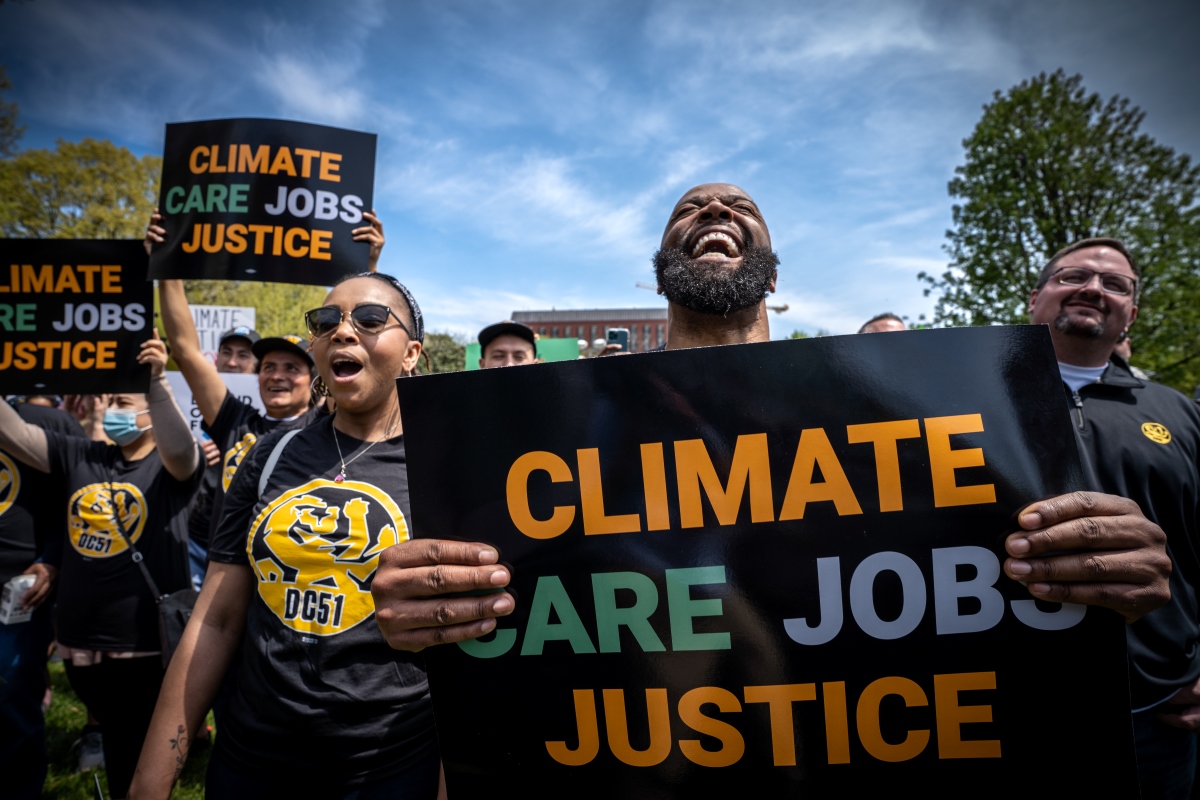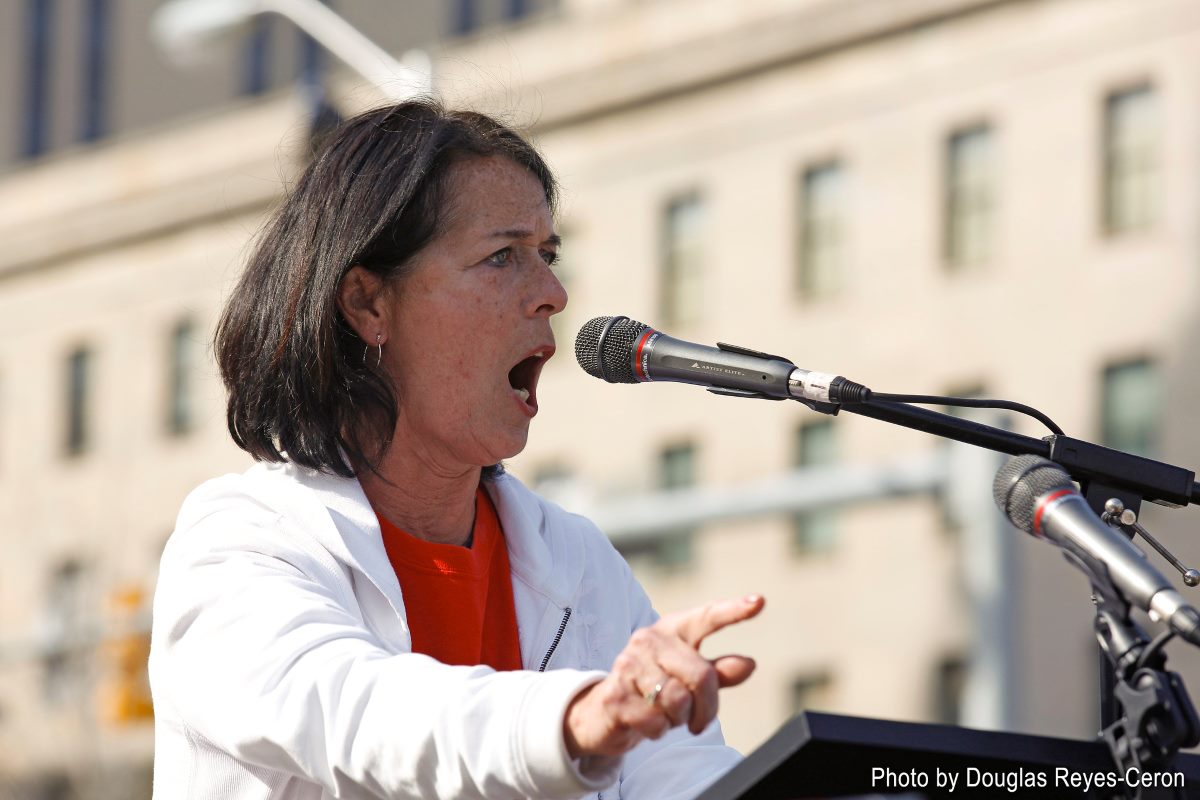
On Juneteenth, A Stark Look at Federal Environmental Justice Rollbacks – and an Opportunity to Push Back
Jun 19, 2025
 Lois Gibbs speaks at a 2014 rally in Baltimore. Credit: Chesapeake Climate, Douglas Reyes-Ceron, Flickr.
Lois Gibbs speaks at a 2014 rally in Baltimore. Credit: Chesapeake Climate, Douglas Reyes-Ceron, Flickr.
This Women’s History month we’re honoring Lois Gibbs, who led her community in a fight against toxic waste in the 1970s and sparked a national cleanup program that continues to benefit numerous communities throughout the country to this day.
In 1978, Gibbs discovered that her neighborhood of Love Canal, Niagara Falls, New York was built on a landfill containing over 20,000 tons of toxic chemical waste that was poisoning her community. Without any prior experience in community activism, she spent the next three years leading her neighbors in a battle to force the local, state, and federal government to take responsibility for mitigating any further harm.
Through grassroots protests, petitions, and press conferences Gibbs and her neighbors managed to garner enough media attention to force federal officials to take action. By 1980, her efforts resulted in the evacuation and relocation of over 800 families and the passage of the Comprehensive Environmental Response, Compensation, and Liability Act, also known as Superfund.
The Superfund program, administered by the Environmental Protection Agency, helps clean up toxic waste sites left behind by manufacturing, landfills, mining and other industries or incidents and holds polluters accountable. Responsible parties are forced to either perform cleanups or reimburse the EPA for cleanup costs. In the event that there is no responsible party, Superfund provides the EPA with funding to clean up the site.
The Superfund law is crucial for safeguarding human health and the environment. The toxins found at these sites contain pollutants that jeopardize the health of adjacent communities by increasing the risk of adverse health impacts like “infant mortality, mental health, water and food-borne illness, and cancer.”
National press coverage made Gibbs a household name, but her work did not end with Love Canal. In 1980 she formed the Citizens Clearinghouse for Hazardous Waste after receiving thousands of letters from people experiencing similar problems. She was also instrumental in the creation of two bills relating to Superfund and continues to be active in grassroots efforts to this day. And although the environmental justice movement began in 1968 with the Memphis sanitation strike, Gibbs propelled it by leaps and bounds.
But problems like the one in Love Canal are not a thing of the past, and the kind of pollution that affected Gibbs’s community affects communities of color at a disproportionately higher rate. Today, more than 25% of Black and Hispanic Americans currently live within a three-mile radius of a Superfund site.
Take the historically Black community of Navassa, North Carolina. The town is nearly 60% black, and from the mid 1930’s to the mid 1970’s, was home to a wood treatment plant that poisoned the surrounding land. Decades after the plant closed tests still show unsafe levels of chemicals like naphthalene, a possible carcinogen, in residential areas. Today, thanks to the kind of community activism Lois Gibbs set the standard for, the Superfund program is facilitating a cleanup in Navassa that will ultimately turn the toxic area into a public park.
Similarly, the former Havertown PCP Superfund site stands out as an exemplary success story for its excellence in stakeholder engagement. The Havertown wood treatment operation contaminated the groundwater and soil with Pentachlorophenol (PCP), an incredibly toxic chemical that can damage the respiratory tract, blood, kidneys, liver, and immune system, and has been linked to cancer. After the cleanup, the site was repurposed to benefit the local community by building the Haverford Area YMCA, a fitness facility that services preschoolers, teens and families.
Superfund sites are all over the country – you can use this map to see which sites are near you, and how they’re being addressed. The fact that the EPA uncovers and addresses this legacy pollution is a testament to Lois Gibbs’s hard work, not just in the 1970’s but for decades on and into the present day.
Huge cleanup projects at Superfund sites aren’t free, of course. So it’s good that in 2021 President Biden signed the Infrastructure Investments and Jobs Act, which invested $3.5 billion into the Superfund program. In addition, Biden’s Inflation Reduction Act also reinstated the Superfund Tax, which had expired in 1995. Now, polluters again have to pay into a fund that goes towards paying for cleanup, relieving the burden of these costs from taxpayers. The tax and the additional funding has allowed the Biden administration to start clean-up operations at more than 150 toxic waste sites, helping to deliver on the Biden-Harris administration’s commitment to environmental justice.
When Lois Gibbs started her work she was a mother of two without any experience in community organizing. Faced with the reality that her family and neighbors were in jeopardy, she took action and instigated the passage of a federal law to clean up toxic legacy pollution.
As we take crucial steps towards cleanup and environmental justice, we honor the legacy of vanguards like Louis Gibbs and the resilience of communities fighting for a healthier future. Because of her efforts, and those of environmental health activists after her, over 400 sites have been completely cleaned up and 152 have been partially cleaned up. Moving forward, we have an obligation to ensure that no community is left behind or forgotten. Everyone has the right to a clean, safe environment. Lois Gibbs reminds us that a single person can initiate a chain reaction that can lead us to a greener future.
Join the fight to protect people and the planet by taking action online or by connecting with your local LCV state affiliate. You can also find out more about how to fight against toxic threats through the organization founded by Lois Gibbs, the Center for Health, Environment and Justice.